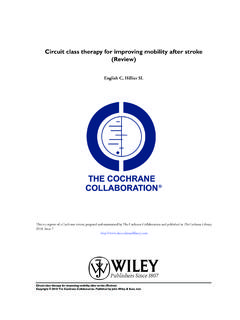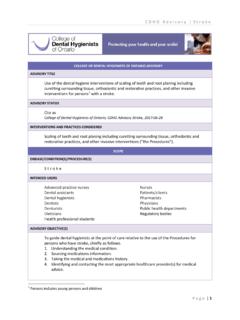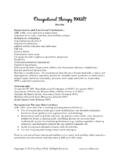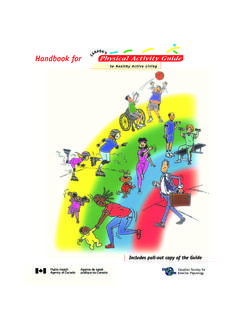Transcription of Healing After Carotid Endarterectomy - Roper St. Francis
1 Roper St. Francis has programs in place that can help you modify your Francis Hospital Diabetes Treatment East Medical Office Building(843) 402-1099 Smoking Cessation Classes (843) 402-CAREL owcountry Senior Center (843) 762-9555 Roper Hospital Cardiac Wellness & Rehabilitation (843) 724-2993St. Francis Hospital Cardiac Rehab West Medical Office Building (843) 402-1271 For a doctor s referral, call 402-CARE or (800) After Carotid IS Carotid Endarterectomy ? Carotid Endarterectomy is an operation that removes plaque formation from the artery in your neck. The arteries are widened to permit blood flow to the brain by making an incision along the skin folds in the neck. A shunt (tube) may be used to supply blood to the brain during surgery.
2 The surgery takes one to two hours under general anesthesia. The scarring is minimal and heals CAUSES BLOCKAGE?Certain diseases may cause changes in blood flow in the artery. Some of these diseases include: atherosclerosis (hardening of the arteries), high blood pressure, peripheral vascular disease or peripheral arterial is a deposit of fat, cholesterol and calcium that restricts blood flow causing the artery to become smaller and in some cases closing the artery INVOLVED IN A Carotid ENDARTERECTOMYT here is some risk with any surgery. Risk factors vary with each person. Risks depend on the Carotid artery disease and the type of surgery being include: 1. Stroke/TIA: The Carotid artery is clamped to allow the surgeon to work in the diseased area.
3 This may cause blood flow to the brain during this time to be insufficient, resulting in an ischemic stroke. To prevent this from occurring, EEG monitoring is used and a shunt (tube) may be used to restore blood flow to the brain during surgery. 2. Heart Attack: Atherosclerosis may cause narrowing of the coronary artery in the heart. If symptoms of heart disease are present, you may be referred to a Other: Minor nerve damage that may cause difficulty in swallowing or tongue coordination, skin numbness, swelling and wound handbook is designed to help you understand Carotid artery disease and how to care for yourself After surgery. Your nurse will go over what you have read and answer any questions you may have. Share the handbook with your family, keep it with you during your stay and take it with you when you leave the Endarterectomy GUIDELINESGUIDELINES fOR:DAY BEfORE SURGERYDAY Of SURGERYDAY After SURGERYTESTS Blood work, chest X-ray, other tests as neededBlood work as neededBlood work within normal limits for patientTREATMENTSP hysical assessments, prepare neck for surgery, shave and/or cleanse with special soap Vital signs taken, nurse will check incision for drainage and swelling, and check strength in arms, legs, ability to smile, frown and short-term memory.
4 Incentive spirometer Healing , no complications (bleeding, infection) noted and normal strength in arms & arms and legs returnedLINES & TUBES Heart monitor, pulse oximetryHeart monitor, pulse oximetry, IV, Jackson Pratt drain, Foley catheter in bladderAll monitors removedMEDICATIONS Medication as ordered by doctorPain medication, antibiotic, IV fluidsPatient is educated on when to use pain medicationsNUTRITION Nothing to eat or drink After midnight the night before or morning of surgeryBegin drinking clear liquids, report any problems swallowing. Diet may be advanced to solid food if no nausea and tolerating regular diet and understands any dietary changes that may need to be madeACTIVITY UnrestrictedBed rest with head of bed elevated to 30 degreesFirst day After surgery, out of bed to chair early and then walking in hall with staff prior to being discharged.
5 Patient will be advised when to return to normal activity & BOWELE mpty bladder before surgeryUrine output measured from Foley catheter by staffUrinary catheter removed early first day After surgery. Patient must urinate prior to Review education booklet and address any questions or concernsReview pain control scale with patientDiet, medication and discharge materials given to patient. Any changes in diet, medications or activities of daily living HOMED ischarge needs discussedInclude family or significant other in teachingPatient and family state understanding of discharge instructions and know when to notify doctor of changesAfTER SURGERYD uring recovery, your nurse will continue to do vascular checks. This consists of checking your extremities for color, temperature, pulse and sensation.
6 You may continue to receive a small amount of oxygen for the first few hours After returning to your room. Report any increases in shortness of breath, chest pain or severe headaches. The Foley catheter may be inserted during surgery to monitor your urine output. The Foley catheter will remain in place until 6 the next day. Intravenous (IV) fluids are given until you are able to orally take food and liquids. You will remain in bed the first night of surgery with your head elevated 30 degrees. If you have compression stockings on your legs, it will help increase blood flow and decrease your risk of blood : Your nurse will give you medication that has been ordered by your doctor. DO NOT take any medications from home while in the hospital. If you need these medications your doctor will order them and the nurse will administer them to : The first day After surgery you will be expected to be out of bed, in a chair and walking around the unit with a staff member.
7 It is important that you use your incentive spirometer (triflow) every one to two hours while awake. This device will assist in your breathing. You should cough and take deep breaths at least every two hours. These exercises are very important in reducing your risks of getting pneumonia while in the hospital. Diet: You will be given a clear liquid diet when you return to your room. As you tolerate food and drink, your diet will be advanced to : When bathing remember not to submerge your incision in a tub bath. Showers are best until your doctor advises you otherwise. Do not apply any lotions, shaving cream, aftershave lotions, powders, colognes or perfumes on your incision. These items increase your risk of : No smoking! Nicotine causes narrowing of the arteries, which decreases blood flow.
8 Smoking also increases your heart rate and blood : Drink in moderation. DO NOT mix alcohol with any HOMEThis is a checklist that will help you care for yourself at home . It is important that you and your family complete the following checklist before leaving the hospital:r Review medication information with your nurser Know what problems to report to your doctor and who to call for problems and concernsr Know how to care for your woundsr Find out any diet changesTHE Healing PROCESSS oreness After surgery is normal. It is also normal to feel tired for a few days. Anesthesia will have this effect. Eating well After surgery is important. A balanced diet will help you heal. Remember you do not heal when you hurt, so if you need your pain medication be sure to take it as prescribed.
9 With pain medications sometimes comes constipation. If needed, take a stool softener or eat more fruits such as prunes or apples. Use whole wheat bread instead of white bread. Try bran muffins and cereals with fiber like All Bran. Drink about eight cups of water a day unless your doctor has limited your fluids. Try walking for exercise; this will help with movement of your fOR YOURSELf at home Check your incision every day. You may take showers, but do not take tub baths until your incision is fully healed. Until then, wash it with warm water and soap, then pat dry. Do not apply anything to your incision. Steri-strips may become loose and may fall off before your follow-up appointment, this is normal. Report any signs of infection to your doctor.
10 Things to look for are excessive drainage, redness, warmth and swelling. Take your pain medication as ordered. Call your doctor if you experience excessive ACTIVITIES AT HOMEF eeling fatigued when you return home is normal. Rest is very important the first few days After your surgery. You may take a few short walks during the day, but otherwise resting and napping is helpful for you to regain your energy and helps the Healing should not drive for a week to 10 days, no heavy lifting of anything heavier than five pounds, no yard work, sports activities or house cleaning for the first few weeks; no taking any long car or plane rides for the first 4-6 weeks, or until After your first post-surgical visit to the surgeon s office. fOLLOW-UP CAREB efore going home you will be given a follow-up appointment with your surgeon.










